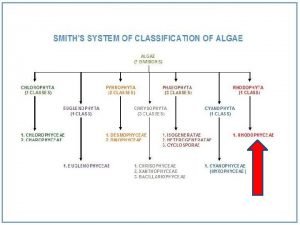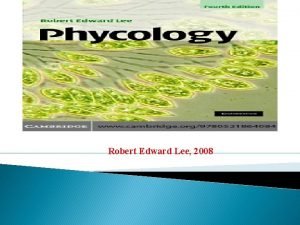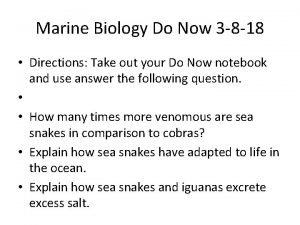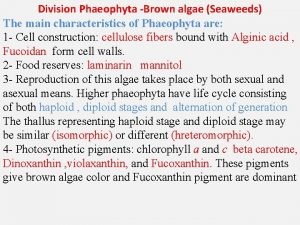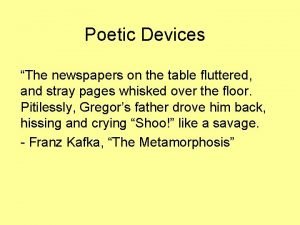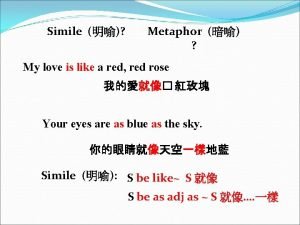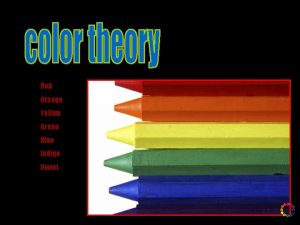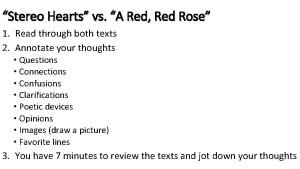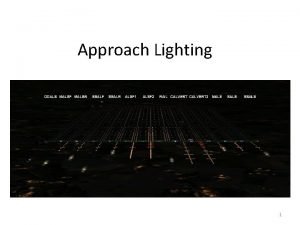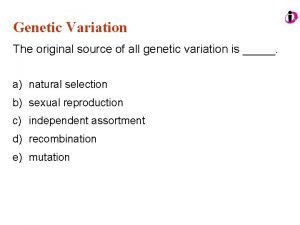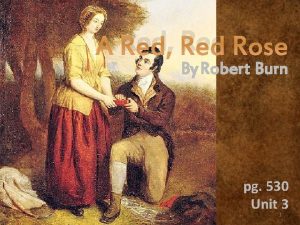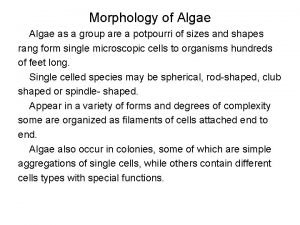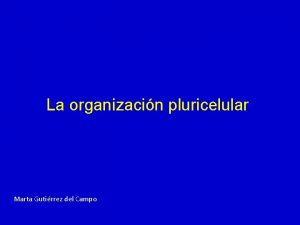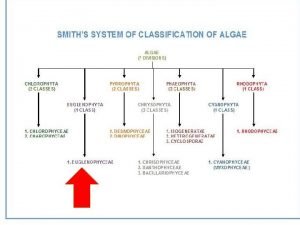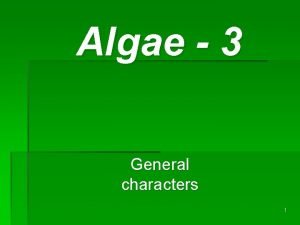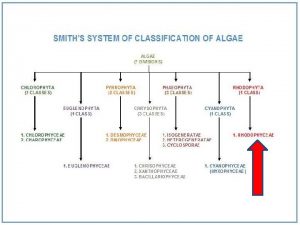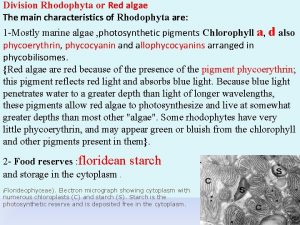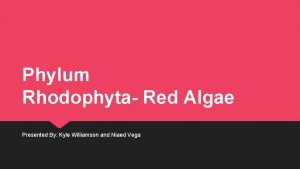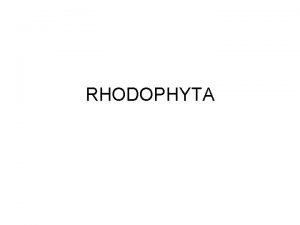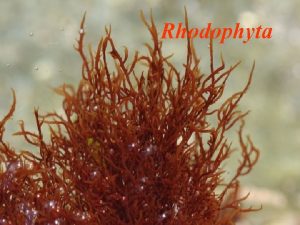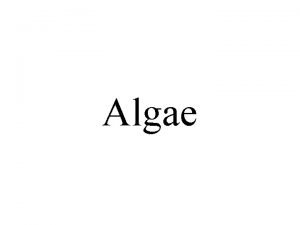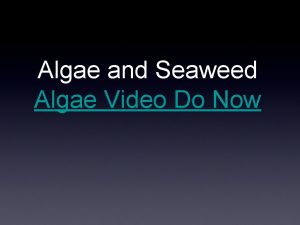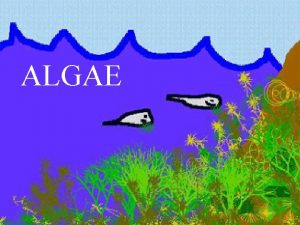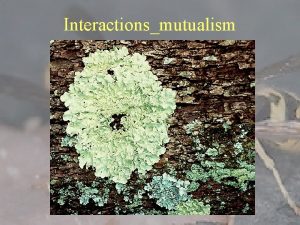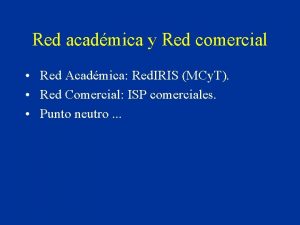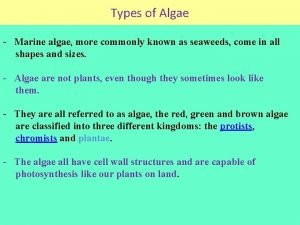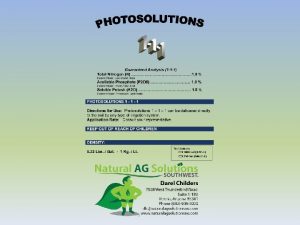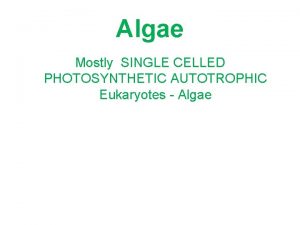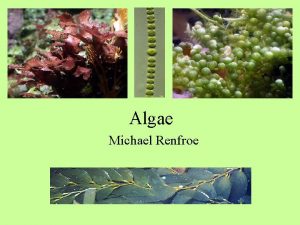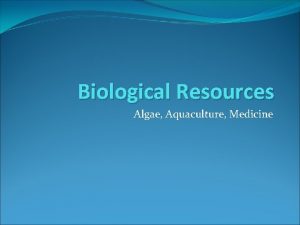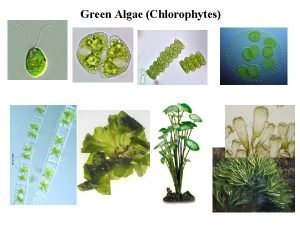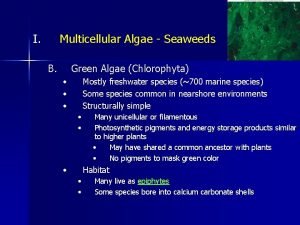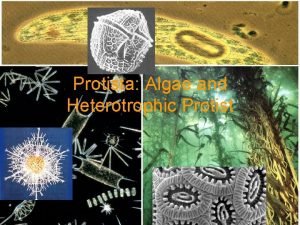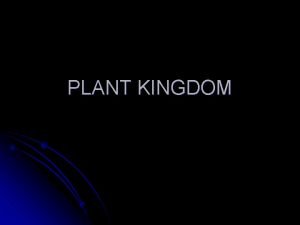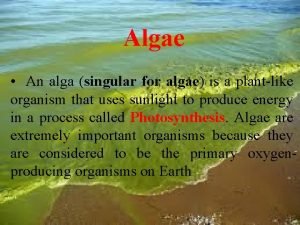Division Rhodophyta or Red algae Division Rhodophyta or



























- Slides: 27


Division Rhodophyta or Red algae

Division Rhodophyta or Red algae The main characteristics of Rhodophyta are: 1 -Mostly marine algae , photosynthetic pigments Chlorophyll a, d , phycoerythrin, phycocyanin and allophycocyanins arranged in phycobilisomes, {Red algae are red because of the presence of the pigment phycoerythrin; this pigment reflects red light and absorbs blue light. Because blue light penetrates water to a greater depth than light of longer wavelengths, these pigments allow red algae to photosynthesize and live at somewhat greater depths than most other "algae". Some rhodophytes have very little phycoerythrin, and may appear green or bluish from the chlorophyll and other pigments present in them}.

2 - Food reserves : floridean starch and the storage of starch in the cytoplasm. (Florideophyceae). Electron micrograph showing cytoplasm with numerous chloroplasts (C) and starch (S). Starch is the photosynthetic reserve and is deposited free in the cytoplasm.

Floridean starch: Most red algae store their sugars as glycogen, or Floridean starch, Glycogen is a long chain of glucose sugars. This Floridean starch is very different from the starch that brown or green algae store. Greens have a grainy starch that reacts with iodine to create a black color (said to be IKI +). Brown algae have an oily starch that doesn't produce any color when put to the iodine test (IKI -). Reds, which lie somewhere between those two, produces a pinkish brown color in response to iodine-exposure (also considered IKI -). Glycogen: Floridean starch

3 -Plant body is mostly thalloid, non-motile and complex.

4 -Sexual reproduction is oogamous Male reproductive cells, there are not sperm, but instead are called "spermatia". They rely entirely on water movement to carry them to the female reproductive cell (which, in Rhodophyta, is called a carpogonium instead of an egg). Sperm = Spermatia Egg = Carpogonium

5 -Motile reproductive cells are absent 6 -Cell walls consist Cellulose fibrils embedded in an amorphous matrix polysaccharide. The polysaccharide are at least two types : agar or Carrageenan. some deposit Ca. CO 3 -- coral line red algae. 7 - That predominate along the coastal and continental shelf areas of tropical, temperate and cold-water regions

8 -Most of the red algae in the wall of separation between adjacent cells contain communications called Pit connections. Pit Connections Pit connections are unique cell connections found in almost all red algae. Pit connections can be defined as the opening in the cell wall between two cells which is filled in by a plug and plug cap. They can form either during cell division, primary pit connections, or between two cells which come to lie near each other, secondary pit connections.

The diagram shows the formation of a primary pit connection. After the nucleus divides during cell division, the cross wall begins to grow inwards (a), but stops before it completely closes the opening between the two cells (b).

Parallel vesicles line up in this aperture (c) and attract electron -dense material to the opening. This electron-dense material is surrounded by a membrane to form the "plug" and stabilized on either side by a flattened vesicle, or "plug cap" (d).

Rhodophyta Morphology -Unicellular- solitary non motile cells - Filamentous- chain of cells -Parenchymatous- undifferentiated, - Pseudoparenchymatous- form of thallus composed of interwoven continuous filament - Polysiphonous

Polysiphonous composed of tiers of vertically elongated cells, transversely arranged, the lateral cells around acentral axis (siphon)central filament surrounded by 4 or more pericentral cells Polysiphonous

Sexual Reproduction in Red Algae • Oogamy occurs in all red algae • Carpogonium: larger, non-flagellate female gamete produced in carpogonia on female gametophyte • Carpogonia are produced at the tip of special branches (carpogonial branches); typically flask-shaped with long, thin neck called trichogyne • Spermatium: non-flagellate male gamete produced in spermatangium on male gametophyte; spermatia move passively (currents) to carpogonia • Fertilization: spermatium fused with tip of trichogyne; a channel is enzymatically opened to allow the spermatium‘s nucleus to enter • Carpospores: several diploid spores produced by mitosis of the zygote spermatangium Carpogonium



Classification of Rhodophyta; Classification only one class, Class: Rhodophyceae This class includes two groups of sub-class: Subclass: Bangioidae Bangia Subclass Floridoidae. Polysiphonia subclass: Bangioidae Carpospores are released, settle, and grow into an independent sporophyte Conchocelis phase: filamentous sporophytes were regarded as different species Conchospores are released by the sporophyte (diploid!) Meiosis occurs upon germination of conchospores, producing 4 haploid cells, two male, two female Order: Bangiales Genus: Bangia

1 N 2 N 1 N 1 N 2 N Meiosis

Bangia 1 - Marine or freshwater habitats. 2 - small thalli with rapid growth and high reproductive. 3 - contain chlorophyll a and sometimes chlorophyll d, as well as accessory pigments such as phycobilin pigments and xanthophylls. 4 - Un branched filament in early development; rhizoidal extensions of lower cells 5 -Asexual reproduction by monospores 6 - Pit plugs present in conchocelis stage but not in gametophyte 7 -Inhabits upper intertidal zone on rocks 8 -Filaments are 10 cm long and 0. 15 mm diameter

Subclass : Floridoidae Order: Ceramiales • Floridophyceans Fertilized carpogonium produces diploid carposporophyte. Carposporophyte produces and releases carpospores; carposporophytes always live on the female gametophyte and receive nutrients from the gametophyte Cystocarp is the single carposporophyte plus the gametophyte tissues surrounding and protecting it. Each fertilized carpogonium can produce several cystocarps due to nuclear transfers among connected filament cells Carpospores grow into a second, multicellular, diploid generation, the tetrasporophyte Tetrasporophyte produces tetraspores in tetrasporangia Meiosis occurs upon germination of tetraspores, producing haploid gametophytes again



Genus: Polysiphonia is a red alga, filamentous and usually well branched some plants reaching a length of about 30 cm. They are attached by rhizoid or to a rocky surface or other alga. The thallus (tissue) consists of fine branched filaments each with a central axial filament supporting pericentral cells. The number of these pericentral cells, 4– 24, is used in identification.

Compare between Bangiophycidae and Florideophycidae Subclass: Bangioidae Subclass: Florideoidae 1 - “simple” reds 2 -simple unicellular or multicellular parenchymatous blades 3 - marine, terrestrial, freshwater 4 - uninucleate 5 -one stellate chloroplast per cell 6 - pit connections absent 7 - biphasic life history 8 -Growth through diffused intercalary cells 1 -advanced reds 2 - Thallus relatively complex , uniaxia or polyaxial. 3 -marine, freshwater 4 -almost always multinucleate 5 -many discoid chloroplasts 6 - pit connections present between the adjacent cells 7 - triphasic life history 8 - Growth through a single apical cell.

Natural and Human Uses: • Red algae are eaten by fish, crustacens, worms and gastropods. Red algae are also eaten by humans. Two examples are nori, which is used in sushi The high vitamin and protein content. • Red algae are used to produce agars, which are gelatinous substances used as a food additive and in science labs as a culture medium. • Red algae is also treat the herpes simplex virus. • Phycocolliods = dervived from mucilagenous polysaccharides of cellwalls • Thickeners, Stabilizers, Gels • Two important phycocolliods:

1 - Carageenan (toothpaste, cosmetics, chocolate milk, ice cream, sweet gels, pet foods), 2 -Agar (food gel, pharmaceutical capsules, medium for Culturing microorganisms, gel electrophoresis.

Coralline Red Algae • Precipitate calcium carbonate in their outer cell wall layers; • Rigid extracellular matrix that contributes to the formation of coral reefs.
 Sexual reproduction in red algae
Sexual reproduction in red algae Rhodophyta unicellular or multicellular
Rhodophyta unicellular or multicellular Economic importance of phaeophyta
Economic importance of phaeophyta Pseudoparenchymatous algae
Pseudoparenchymatous algae Red algae
Red algae Red algae
Red algae Fucus vesiculosus kingdom and division
Fucus vesiculosus kingdom and division A red red rose literary devices
A red red rose literary devices Figure of speech about love
Figure of speech about love Indigo orange yellow pink
Indigo orange yellow pink Why does a red ball look red
Why does a red ball look red Simile in stereo hearts
Simile in stereo hearts Red gri
Red gri Orange yellow green
Orange yellow green Alsf-1 vs alsf-2
Alsf-1 vs alsf-2 Red over red the captain is dead
Red over red the captain is dead The original source of all genetic variation is _____.
The original source of all genetic variation is _____. A red red rose
A red red rose 369 times 2
369 times 2 What is the missing number in the synthetic-division array
What is the missing number in the synthetic-division array Long division and short division
Long division and short division Quadratic long division
Quadratic long division Nutritional requirements of microorganisms
Nutritional requirements of microorganisms Chlorella algae
Chlorella algae Aztec algae cheesecake
Aztec algae cheesecake Diatoms are multiflagellate
Diatoms are multiflagellate Heterogamy in algae
Heterogamy in algae Alga
Alga
